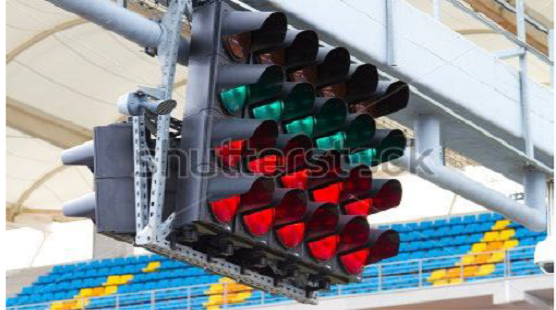Formula One – Rules & Regulations
A Formula One race starts with a warm-up lap, called the formation lap and the pit lanes are opened of this purpose 30 minutes before the actual race begins. Pit lanes are tracks away from the grid and are parallel to the start/finish line.
During this time, the drivers are free to take any number of warm-up drives, without actually going on the grid. After the pit lane closes, the drivers must take their places on the grid in their qualifying order.
Once all the cars have taken their positions on the grid, the race begins with the starting lights − 10 red lights in 5 pairs of columns.

Each column lights one after the other, at an interval of 1 second from left to right direction. After all 5 columns are illuminated, they stay in that way for a few seconds and then all of them are extinguished at once and the race begins.
If the start is interrupted due to any circumstances, the 5 red lights illuminate again but are not extinguished, instead orange lights are lit up and the race is restarted.
The drivers who finish at first, second and third positions at the end of the race stand on a podium and are awarded trophies. A constructor’s trophy is also presented to the winner’s team.
Race Distance and Duration
The length of the race must be 305 km (260 km in case of Monaco GP) and is defined as “the smallest number of complete laps that exceeds 305 kilometers”.
The number of laps in a race is obtained by dividing 305 by the length of a lap, which differs from track to track.
The duration of the race cannot be more than 2 hours. If the allocated time of 2 hours is exceeded, the race is considered to be finished at the end of the ongoing lap.
Refueling
Refueling during races was allowed earlier, but from 2010 this has been abolished. As a result, every car must ensure a loaded tank before the race begins. However, refueling during races will be permitted again from the 2017 season.
Racing Flags
Similar to motor sports and other racing competitions, racing flags are used in Formula One to send out various messages and signals to the drivers like the race start or finish, lap indication, bad weather indication, etc.
Three categories of flags are used in F1 racing. They are −
-
Status Flags
-
Instruction Flags
-
The Chequered Flag
Status Flags
There are 5 status flags −
-
Green Flag − It is used to indicate the start of a race or the restart of a race stopped due to a temporary delay.
-
Yellow Flag − It is an indication of caution to the drivers to go slow due to some accident or hazard on the track or due to rain.
-
Red Flag − It is an indication of danger, especially bad weather conditions and signals the drivers to stop or return to the pit immediately, depending on the situation.
-
Red & Yellow Striped Flag − It indicates that the conditions of the track have been modified by car debris, spilled oil or sand and could cause problems like loss of control and reduced grip.
-
White Flag − It is displayed at the end of free practice sessions (Friday & Saturday) on the last corner and pit straight, indicating to the drivers that other drivers are engaged in practice on pit straight.
Instruction Flags
These flags communicate with only one driver at a time and are of 5 types −
-
Black Flag − It is shown to impose penalty when a driver has broken some rules and instruct the driver to get back to the pit.
-
Black Flag with Orange Circle − It also indicates that a car is being asked to return to the cockpit due to technical problems like fuel leak, water leak or oil leak, that might interfere with the proceedings of the race.
-
Per-bend black/white flag − One diagonal of this flag is black and the other diagonal is white and is an indication of penalty on the driver due to lack of sportsmanship behavior.
-
Black flag with white cross − This flag is black with two white diagonal crosses and is waved when a driver ignores other black flags and instructs the driver that his car is not scoring anymore.
-
Blue Flag − It indicates to the driver that another faster car is coming towards his direction and that he should make way for the faster car.
The Chequered Flag
The chequered flag is waved at the finish line, indicating that the race is officially over.
